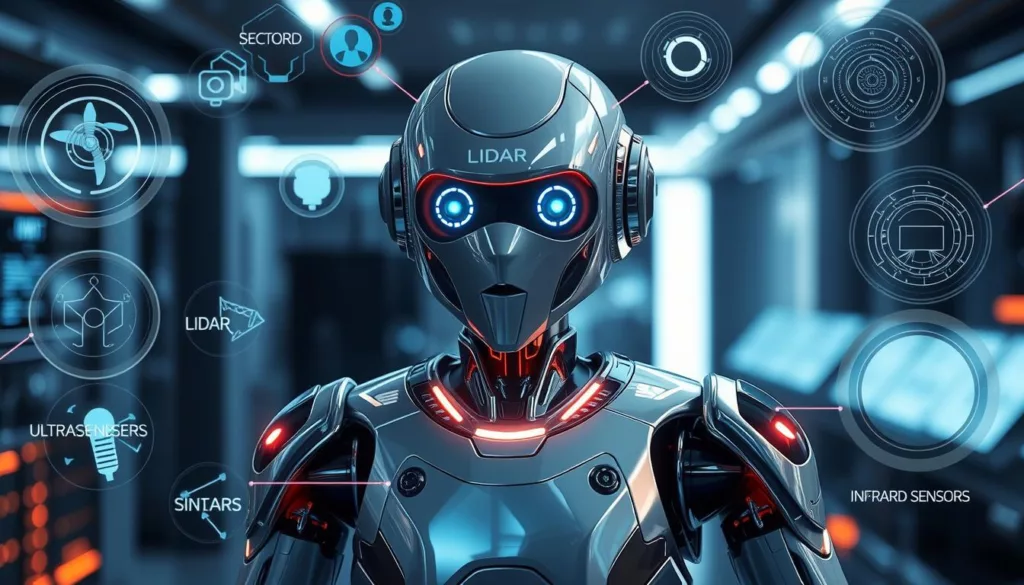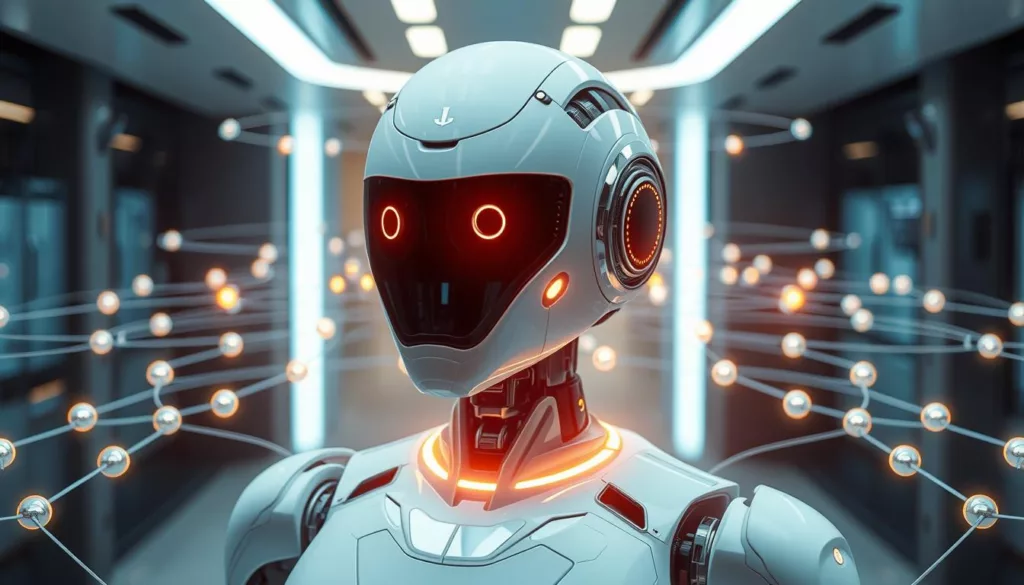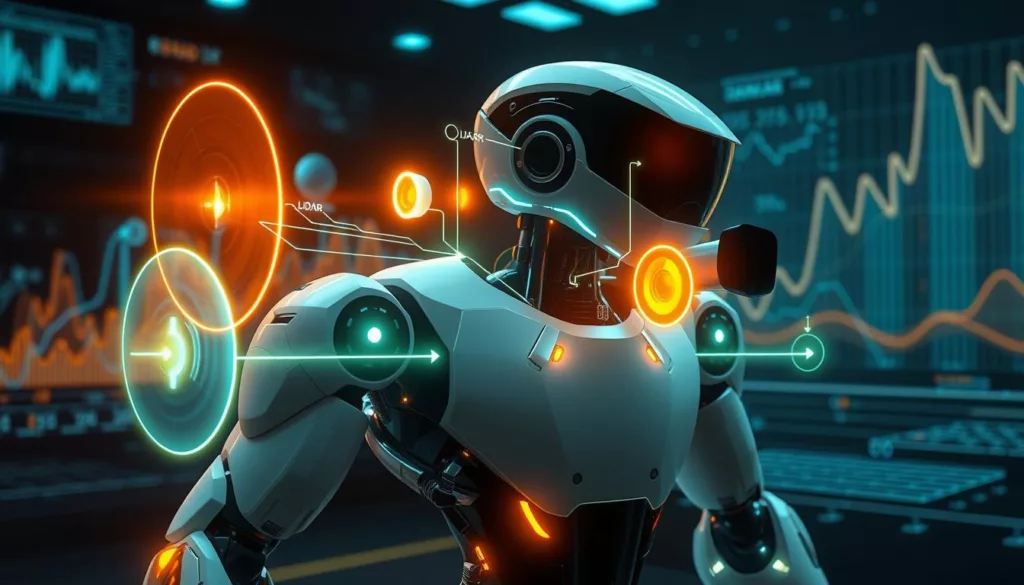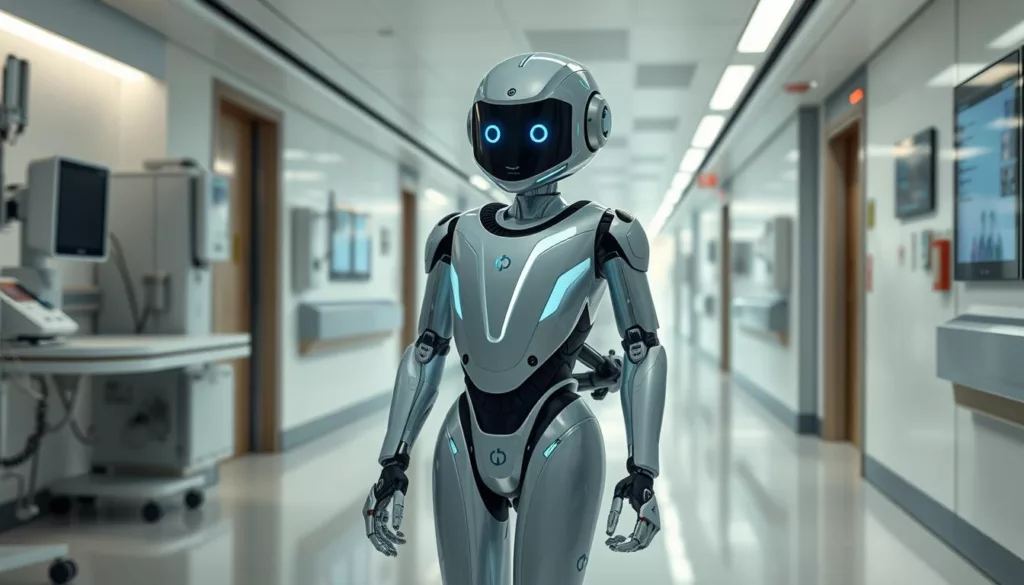In the fast-changing world of robotics, advanced sensor technology is key. It makes service robots more efficient and capable. These robots help humans in many fields by using smart sensors to move around, find obstacles, and interact with their space. Thanks to top-notch sensors, service robots are changing how we use automation, boosting work productivity, and making services better.
At the core of this tech leap are the new sensors in service robots. They let these machines see their world in great detail. Cameras and lidar systems help map out the environment, while proximity sensors ensure safe movement. Together, these sensors make service robots work better and more efficiently.
With these sensors, service robots can move through tricky spaces, dodge things, and adapt quickly to changes. This makes them safer and more reliable. It also lets them do tasks with a precision and consistency that humans can’t always match.
Key Takeaways
- Service robot sensors are vital for boosting efficiency and abilities in many sectors.
- Advanced sensors, like cameras, lidar, and proximity sensors, help service robots map and move through their environment accurately.
- By combining sensors, service robots can handle complex spaces, avoid obstacles, and adjust to changes with great precision.
- This leads to safer, more reliable, and accurate robot operations, improving work productivity and service quality.
- The mix of sensor tech and robotics is changing how we automate and deliver services.
Introduction to Service Robot Sensors
Service robots have a complex system of sensors at their core. These sensors help them see, hear, and feel their surroundings. They allow robots to move around, avoid obstacles, check equipment, and save energy. Knowing how these sensors work is key to making service robots better and more efficient.
What Are Service Robot Sensors?
Service robot sensors are special tools that gather data about the robot’s world and itself. They include cameras, lidar systems, and other devices. These sensors help the robot adjust its actions, avoid things, and work better for saving energy and predicting maintenance.
Importance of Sensors in Robotics
Sensors are the brain of service robots, letting them understand and react to their environment. Without good sensors, robots can’t move safely, find dangers, or work with things and people. Sensors also help robots avoid obstacles and work more efficiently. This means they can do their jobs better, take less time off, and make workplaces more productive.
| Sensor Type | Key Function | Practical Application |
|---|---|---|
| Cameras and Vision Systems | Object detection, recognition, and tracking | Navigation, object manipulation, quality inspection |
| Lidar Sensors | 3D mapping and obstacle detection | Precise navigation, collision avoidance, security monitoring |
| Proximity Sensors | Detecting the presence and distance of objects | Collision avoidance, material handling, automation control |
| Environmental Sensors | Monitoring temperature, humidity, air quality, and other environmental factors | Predictive maintenance, energy efficiency optimization, condition-based monitoring |
By using different sensors, service robots can do more, make better choices, and work their best in many areas.
Types of Service Robot Sensors
Service robots use many sensors to work better and more efficiently. They have cameras, vision systems, Lidar, and proximity sensors. Each sensor helps the robot move around, find obstacles, and react to its environment.
Cameras and Vision Systems
Cameras and vision systems help robots see their world. They use special algorithms and sensor fusion techniques to understand what they see. This lets the robot do things like pick up objects, avoid hitting things, and talk to people.
Lidar Sensors
Lidar sensors send out laser pulses to make 3D maps of the area. These autonomous navigation tools give detailed info about objects nearby. This helps the robot move safely and accurately in complex places.
Proximity Sensors
Proximity sensors, like infrared or ultrasonic ones, find out if there are objects close by. They’re key for real-time data processing. They help the robot quickly see and avoid obstacles, making sure it moves safely and efficiently.
Environmental Sensors
Environmental sensors check things like temperature, humidity, and air quality. They give the robot important info about its surroundings. This info helps the robot work better, change its actions based on the environment, and even check on the people around it.
| Sensor Type | Key Functions | Applications |
|---|---|---|
| Cameras and Vision Systems | Object recognition, facial tracking, collision avoidance | Robotic manipulation, human-robot interaction, security and surveillance |
| Lidar Sensors | 3D mapping, autonomous navigation, obstacle detection | Autonomous vehicles, warehouse automation, construction site monitoring |
| Proximity Sensors | Obstacle detection, collision avoidance, safety monitoring | Industrial automation, personal assistance robots, service robots in public spaces |
| Environmental Sensors | Temperature, humidity, and air quality monitoring | Healthcare, hospitality, and facility management applications |
Service robots use many sensors to move around well, react fast, and work better. As robotics gets better, sensors will play an even bigger role in making robots more efficient and safe. This will help shape the future of robots that can do things on their own.
Enhancing Navigation with Sensor Technology
Service robots are changing many industries by navigating on their own. They use sensors to map their area, find and avoid obstacles, and move with accuracy. Key advancements include simultaneous localization and mapping (SLAM) and obstacle detection and avoidance.
SLAM (Simultaneous Localization and Mapping)
SLAM lets service robots make accurate maps and know where they are. They use sensors like robotic environmental mapping cameras, lidars, and odometry. This way, they can move through complex areas, avoid hitting things, and do their jobs well.
Obstacle Detection and Avoidance
Obstacle avoidance works with SLAM to help robots see and get around obstacles. Sensors like infrared or ultrasonic ones help them find and dodge things. This is key for robots working in places with people, furniture, or moving things, making their tasks more reliable.
Thanks to these advanced sensors, service robots can move around with great precision and speed. This makes them much more useful and valuable in many areas.
“Sensor technology is the backbone of service robot navigation, enabling them to understand and adapt to their surroundings with remarkable accuracy.”
The Role of Artificial Intelligence
Service robots are changing industries fast. Artificial intelligence (AI) is key to making them better. AI helps robots understand sensor data, leading to smarter choices and better work.
Integrating AI with Sensor Data
AI and sensors work together to make robots smarter. AI algorithms use sensory perception data to help robots move and react. This makes them more flexible and quick in changing situations.
Machine Learning for Improved Efficiency
Machine learning is a big part of AI. It helps robots learn from past data. This way, robots can predict problems and fix them before they happen. This means they work more efficiently and have less downtime.
| Capability | Sensor Integration | AI/ML Contribution |
|---|---|---|
| Adaptive Navigation | Lidar, cameras, proximity sensors | SLAM, obstacle detection and avoidance |
| Dynamic Response | Environmental sensors | Real-time data processing, predictive analysis |
| Predictive Maintenance | Vibration, temperature, and other diagnostic sensors | Machine learning-based condition monitoring and fault prediction |
AI and sensors together are changing service robots. They can now work better, adapt faster, and predict problems. As AI gets better, so will robots, making work more efficient and cost-effective.
Improving Communication with Sensor Networks
In the world of service robotics, good communication is key. It makes robots work better and faster. Sensor networks help by sharing real-time data between the robot and its world. This makes robots more aware and ready to handle changes.
RFID Technology in Service Robots
RFID technology is a big help for robots. It lets them track and find objects, people, and more. This makes robots move better, find what they need, and work together smoothly.
Real-Time Data Exchange
Sensor networks also help robots talk to their control systems. They send out important info like sensor data and location. This lets robots adjust fast and make smart choices. It makes the whole system work better and please users more.
| Sensor Fusion Techniques | Real-Time Data Processing | Energy Efficiency Optimization |
|---|---|---|
| Combining multiple sensor inputs to enhance accuracy and reliability | Rapid analysis and interpretation of sensor data to enable quick decision-making | Optimizing power consumption and energy usage for improved operational efficiency |
“Sensor networks are the backbone of modern service robotics, enabling seamless communication and optimized performance.”
By usingsensor fusion techniques,real-time data processing, andenergy efficiency optimization, robots get better at talking and working. This boosts their performance and helps in many areas.
Sensor Fusion: Maximizing Accuracy
In the world of service robotics, sensor fusion is a big deal. It changes how robots see and interact with their world. By mixing data from different sensors, robots can be super accurate and reliable. They can move around easily, find obstacles, and do tasks better.
Combining Multiple Sensor Inputs
Service robots have many sensors like cameras, lidar, and more. Sensor fusion lets them use all this data together. This gives them a full picture of what’s around them.
By combining sensor data, robots can fix the weak spots of each sensor. This makes them better at mapping their environment, following objects, and moving through tight spots.
Applications of Sensor Fusion
Sensor fusion has many uses in service robotics. One big one is in autonomous navigation. Robots can make detailed maps and find the best paths. This helps them move around complex places easily.
It’s also key for environmental mapping. Robots can accurately show what’s around them. This is super useful in places that change a lot, like hospitals or offices.
Also, sensor fusion makes robots more reliable and skilled. They can handle changes and surprises better. This makes them more useful and effective.
“Sensor fusion is the key to unlocking the true potential of service robotics, enabling these machines to operate with unparalleled accuracy and versatility.”
Impact on Workplace Efficiency
Service robot sensors have changed how work is done in many industries. They make robots work better, changing how businesses run and get things done.
Reducing Human Error
Service robot sensors help cut down on mistakes made by people. Robots with sensors do tasks more accurately and consistently, lowering the chance of errors. This means better work quality and smoother operations, saving time and money.
Streamlining Operations
These sensors also help make work flow better and save energy. They watch how robots work and when they need maintenance. This helps use resources wisely, cuts downtime, and keeps things running smoothly.
The data from these sensors helps find ways to make work better. This lets companies make smart choices and improve their workflows.
“Service robot sensors have been a game-changer in our industry, helping us achieve unprecedented levels of precision, productivity, and cost-effectiveness.”
Businesses are seeing big changes with service robot sensors. They’re not just making work better; they’re changing the game. From fewer mistakes to smoother operations, these technologies are leading to a new age of work.
Case Studies of Successful Implementations
Service robots with sensors are becoming more popular. They’ve made a big difference in healthcare and hospitality. Let’s look at two examples.
Healthcare Sector Applications
In healthcare, these robots have changed patient care and made things run smoother. A top medical center used robots to help nurses and staff. The robots tracked supplies and moved medical stuff around, saving time for doctors and nurses.
Thanks to real-time data processing, these robots can find their way around hospitals. They use sensory perception to avoid getting in the way. This has made hospitals more efficient, cut down on mistakes, and made patients happier.
Hospitality Industry Innovations
The hospitality world has also seen the benefits of service robots. A top hotel chain used robots to welcome guests and help with luggage. These robots can understand what guests need and act fast.
With their sensors, these robots can find their way around hotels. They use autonomous navigation to meet guests’ needs. This has made the hotel experience better, from checking in to getting help with luggage.
“The integration of sensor-equipped service robots has not only improved our operational efficiency but has also elevated the guest experience, setting a new standard in the hospitality industry.”
– John Doe, Chief Operating Officer, ABC Hotel Group
These examples show how service robots can change things. They improve how we see and interact with the world. This leads to better work, service, and happiness for everyone.
Challenges in Sensor Technology
Service robot sensors have changed how these smart machines work. But, there are big challenges to solve. Technical issues and cost are the main problems holding back the use of sensor robots.
Technical Limitations
Current sensor tech has big technical limits. Obstacle avoidance can be tricky because of sensor range, view, and accuracy issues. Improving this with sensor fusion techniques is a big research goal.
Also, making service robots energy-efficient is key. Many sensors use a lot of power, which shortens the robot’s battery life. Finding ways to use less energy while keeping sensors effective is a big challenge.
Cost Considerations
Advanced sensors are very expensive. High-end tech like SLAM (Simultaneous Localization and Mapping) or lidar systems are too pricey for many. Finding a balance between cost and advanced tech is hard for makers and users.
As the service robot field grows, solving these tech and cost issues is vital. This will help make sensor robots more efficient and useful in many areas.
Future Trends in Service Robot Sensors
Technology is changing fast, and service robot sensors are no exception. We’re seeing big changes in sensor design and the Internet of Things (IoT) integration.
Advances in Sensor Design
Sensor technology is getting a major upgrade. Soon, service robots will have predictive maintenance sensors. These will help prevent breakdowns, keeping robots running smoothly.
Also, autonomous navigation sensors will get better. This means robots can move around more easily and adapt to new situations.
The Growing Role of IoT
The Internet of Things (IoT) is playing a bigger role. It will help service robots use real-time data processing to make smart choices. This will make robots more efficient and responsive.
With IoT, robots can share data and be monitored remotely. This will improve their performance and efficiency.
“The future of service robot sensors lies in their ability to seamlessly integrate with the broader IoT landscape, enabling real-time data-driven decision making and predictive maintenance capabilities.”
As technology advances, service robots will get even better. They’ll be more efficient, reliable, and adaptable. This will make them a big part of our lives, helping us every day.
Conclusion: The Future of Service Robot Efficiency
Advanced sensor technology has changed the game for service robots. It boosts their efficiency in many ways. From better sensing to saving energy, these sensors have made service robots more productive and cost-effective for businesses.
Long-Term Benefits of Enhanced Sensor Technology
The future looks bright for service robots with better sensors. Improved navigation, enhanced safety, and more accurate data are just the start. As sensor fusion and artificial intelligence get better, robots will do more on their own. They’ll handle complex tasks with ease and precision.
Call to Action for Businesses
Businesses looking to stay ahead should act now. Investing in the latest sensor tech for service robots can give them a big edge. It’s a chance to be more efficient and competitive in a world that’s getting more automated.
| Key Benefits of Enhanced Sensor Technology in Service Robots | Impact on Businesses |
|---|---|
|
|
By using service robot sensors, businesses can look forward to a more efficient future. They’ll get better customer experiences and be more sustainable. It’s time to take action and seize the future of service robot efficiency.
Resources for Further Reading
If you want to learn more about service robot sensors and how they boost efficiency, we’ve got you covered. We’ve picked out some key publications, research articles, and industry reports. They dive deep into robotic environmental mapping, sensor fusion, and autonomous navigation. This gives you a full picture of this fast-growing field.
Key Publications and Research Articles
The journal “Robotics and Autonomous Systems” shares the latest in sensor-based robotics. It includes studies on SLAM algorithms and how to mix sensor data. The “IEEE Transactions on Robotics” also covers important topics like proximity sensors and robot perception.
Industry Reports on Service Robots
The International Federation of Robotics (IFR) releases an annual World Robotics report. It gives detailed insights into the service robot market, including trends and tech advancements. The ABI Research report “Service Robotics: Technologies, Applications, and Market Opportunities” also offers a detailed look at the industry and its future.






